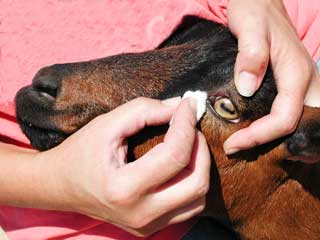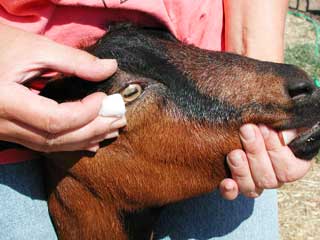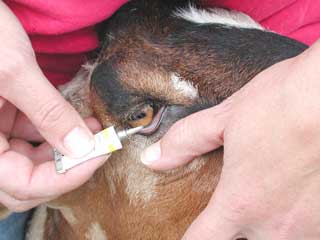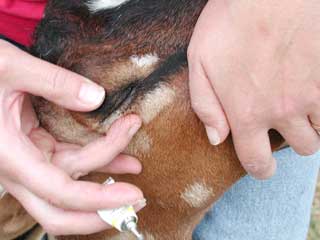Introduction/Clinical Signs: Eye irritation can be a common problem
encountered by animals. The irritation can be simply the result of dirt or
debris in the eye, or it can be caused by injury, infectious disease, or a
specific eye condition (glaucoma, cataracts, ulcers, etc.). Initially, the eye
may become red and irritated. This is often called conjunctivitis. The
sheep/goat may be sensitive to the light and will "squint" or keep the eye
completely closed. Tearing or discharge from the eye is common and can result
from irritation, infection, and disease.
Treatment/Prevention: For mild eye irritation, follow these suggestions:
- Clean around the edges of the eye with a clean washcloth or cotton ball
that has been soaked in warm water. After squeezing any excess water from the
washcloth or cotton, start at the corner of the eye and wipe AWAY from the
eye. Do the same thing on the opposite side of the eye. Gently remove any
discharge or debris found around the eye, being careful not to drag any
discharge over the surface of the eye. Use different cotton balls or areas of
the washcloth for each eye. Both of these methods will help prevent the spread
of infection (see figures #1 & 2).
- Rinse the eye with "artificial tears" or other eye safe product. This can
help rinse out debris and soothe the eye.
- Be sure that hair and eye lashes are kept away from the eye.
For problems that do not seem to improve while implementing the above
suggestions, the animal should be taken to a veterinarian. Conditions that may
seem fairly harmless can soon progress into serious problems that can
permanently damage the eye. If the eye becomes cloudy, red, swollen, very
irritated, painful, or continues to have discharge, veterinarian attention is a
must. The veterinarian may prescribe various ointments or solutions that can be
placed in the eye. Figures #3 & 4 can aid in proper administration of these eye
products.




